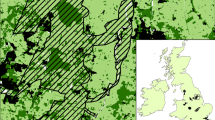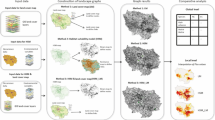Abstract
Existing methods for connectivity analysis still encounter difficulties in explaining functional relationships between network structure and ecological patterns over larger territories or complex structures like dendritic river networks. We propose a method that addresses the problem of scale and resolution in the connectivity analysis of dendritic network structures, illustrated here for the re-colonization of the French Loire river basin by the European otter. The ecological niche factor approach is applied to infer favourable habitat in the river network based on large scale data of land use and hydro-morphology of river segments for the entire river basin. These analyses identified the stressors to the riparian zone of channel straightening, urbanisation and forest fragmentation as the principal factors explaining otter occurrence. Using this estimate of habitat favourability, we used the Integral Index of Connectivity to quantify habitat availability and connectivity in the dendritic river network. When we calculate the integral index of connectivity over different spatial extents by constraining network distances, the scale-sensitivity of the network’s connectivity emerges. Accounting for high mobility by entering larger network distances in the analysis identifies conservation networks and priorities mainly in downstream parts of the river basin, whereas with smaller network distances, more restricted high quality areas in central and upstream parts are highlighted. The presented approach performed better than distribution modelling approaches in explaining species occurrence over the river network and confirms the crucial aspect of connectivity in otter re-colonization.






Similar content being viewed by others
References
Allan JD (2004) Landscapes and riverscapes: the influence of land use on stream ecosystems. Ann Rev Ecol Evol Syst 35:257–284
Arponen A, Lehtomäki J, Leppänen J, Tomppo E, Moilanen A (2012) Effects of connectivity and spatial resolution of analyses on conservation prioritization across large extents. Conserv Biol 26:294–304
Baguette M, Van Dyck H (2007) Landscape connectivity and animal behavior: functional grain as a key determinant for dispersal. Landscape Ecol 22:1117–1129
Barbosa AM, Real R, Marquez AL, Rendon MA (2001) Spatial, environmental and human influences on the distribution of otter (Lutra lutra) in the Spanish provinces. Divers Distrib 7:137–144
Barbosa AM, Real R, Olivero J, Vargas JM (2003) Otter (Lutra lutra) distribution modeling at two resolution scales suited to conservation planning in the Iberian Peninsula. Biol Conserv 114:377–387
Basille M, Herfindal I, Santin-Janin H, Linnell JDC, Odden J, Andersen R, Hogda KA, Gaillard J-M (2009) What shapes Eurasian lynx distribution in human dominated landscapes: selecting prey or avoiding people? Ecography 32:683–691
Beier P, Spencer W, Baldwin RF, Mcrae BH (2011) Toward best practices for developing regional connectivity maps. Conserv Biol 25:879–892
Carranza ML, D’alessandro E, Saura S, Loy A (2012) Connectivity providers for semi-aquatic vertebrates: the case of the endangered otter in Italy. Landscape Ecol 27:281–290
Carrara F, Altermatt F, Rodriguez-Iturbe I, Rinaldo A (2012) Dendritic connectivity controls biodiversity patterns in experimental metacommunities. Proc Natl Acad Sci. doi:10.1073/pnas.1119651109
Carroll C, Mcrae BH, Brookes A (2012) Use of linkage mapping and centrality analysis across habitat gradients to conserve connectivity of gray wolf populations in western North America. Conserv Biol 26:78–87
Chandesris A, Mengin N, Malavoi JR, Wasson JG, Souchon Y (2008) SYRAH-CE: SYstème Relationnel d’Audit de l’Hydromorphologie des Cours d’Eau A relational, multi-scale system for auditing the hydro-morphology of running waters: diagnostic tool to help the WFD implementation in France. In: Gumiero B, Rinaldi M, Fokkens B (eds) Proceedings of the 4th international conference on river restoration, Venice, ITA, 16–21 June 2008
Chetkiewicz C, St. Clair C, Boyce M (2006) Corridors for conservation: integrating pattern and process. Ann Rev Ecol Evol Syst 37:317–342
Clavero M, Hermoso V, Brotons L, Delibes M (2010) Natural, human and spatial constraints to expanding populations of otters in the Iberian Peninsula. J Biogeogr 37:2345–2357
Cortés Y, Fernández-Salvador R, García FJ, Virgós E, Llorente M (1998) Changes in otter Lutra lutra distribution in Central Spain in the 1964–1995 period. Biol Conserv 86:179–183
Eros T, Schmera D, Schick RS (2011) Network thinking in riverscape conservation—A graph-based approach. Biol Conserv 144:184–192
Fagan WF (2002) Connectivity, fragmentation, and extinction risk in dendritic metapopulations. Ecology 83:3243–3249
Fisher SG (1997) Creativity, idea generation, and the functional morphology of streams. J N Am Benthol Soc 16:305–318
Ganio LM, Torgersen CE, Gresswell RE (2005) A geostatistical approach for describing spatial pattern in stream networks. Front Ecol Environ 3:138–144
Godsoe W, Harmon LJ (2012) How do species interactions affect species distribution models? Ecography 35:811–820
Grant EHC, Lowe WH, Fagan WF (2007) Living in the branches: population dynamics and ecological processes in dendritic networks. Ecol Lett 10:165–175
Hannah LEE (2011) Climate change, connectivity, and conservation success. Conserv Biol 25:1139–1142
Hermoso V, Linke S, Prenda J, Possingham HP (2011) Addressing longitudinal connectivity in the systematic conservation planning of fresh waters. Freshw Biol 56:57–70
Hermoso V, Kennard MJ, Linke S (2012) Integrating multidirectional connectivity requirements in systematic conservation planning for freshwater systems. Divers Distrib 18:448–458
Hirzel AH, Hausser J, Chessel D, Perrin N (2001) Ecological-niche factor analysis: how to compute habitat-suitability maps without absence data? Ecology 83:2027–2036
Janssens X, Fontaine MC, Michaux JR, Libois R, De Kermabon J, Defourny P, Baret PV (2008) Genetic pattern of the recent recovery of European otters in southern France. Ecography 31:176–186
Jordán F, Báldi A, Orci KM, Rácz I, Varga Z (2003) Characterizing the importance of habitat patches and corridors in maintaining the landscape connectivity of a Pholidoptera transsylvanica (Orthoptera) metapopulation. Landscape Ecol 18:83–92
Kruuk H (2006) Otters, ecology, behaviour and conservation. Oxford University Press, New York
Laita A, Kotiaho JS, Monkkonen M (2011) Graph-theoretic connectivity measures: what do they tell us about connectivity? Landscape Ecol 26:951–967
Lemarchand C, Amblard C, Souchon Y, Berny P (2007) Organochlorine compounds (pesticides and PCBs) in scats of the european otter (Lutra lutra) from an actual expanding population in central france. Water Air Soil Pollut 186:55–62
Lodé T (1993) The decline of otter Lutra lutra populations in the region of the pays de loire, Western France. Biol Conserv 65:9–13
Loy A, Carranza ML, Cianfrani C, D’Alessandro E, Bonesi L (2009) Otter Lutra lutra population expansion: assessing habitat suitability and connectivity in southern Italy. Folia Zool 58:309–326
MacDonald S, Mason C (1983) The otter Lutra lutra in Southern Italy. Biol Conserv 25:95–101
Mason CF, Macdonald S (1987) Otters: ecology and conservation. Cambridge University Press, Cambridge
Mccarthy KP, Fletcher RJ Jr, Rota CT, Hutto RL (2012) Predicting species distributions from samples collected along roadsides. Conserv Biol 26:68–77
Minor ES, Urban DL (2008) A graph-theory framework for evaluating landscape connectivity and conservation planning. Conserv Biol 22:297–307
Moilanen A, Hanski I (2001) On the use of connectivity measures in spatial ecology. Oikos 95:147–151
Moilanen A, Leathwick J, Elith J (2008) A method for spatial freshwater conservation prioritization. Freshw Biol 53:577–592
Morzillo A, Ferrari J, Liu J (2011) An integration of habitat evaluation, individual based modeling, and graph theory for a potential black bear population recovery in southeastern Texas, USA. Landscape Ecol 26:69–81
Ottaviani D, Panzacchi M, Lasinio GJ, Genovesi P, Boitani L (2009) Modelling semi-aquatic vertebrates’ distribution at the drainage basin scale: the case of the otter Lutra lutra in Italy. Ecol Model 220:111–121
Pascual-Hortal L, Saura S (2006) Comparison and development of new graph-based landscape connectivity indices: towards the priorization of habitat patches and corridors for conservation. Landscape Ecol 21:959–967
Pascual-Hortal L, Saura S (2008) Integrating landscape connectivity in broad-scale forest planning through a new graph-based habitat availability methodology: application to capercaillie (Tetrao urogallus) in Catalonia (NE Spain). Eur J Forest Res 127:23–31
Pinto N, Keitt TH (2009) Beyond the least-cost path: evaluating corridor redundancy using a graph-theoretic approach. Landscape Ecol 24:253–266
Robitaille JF, Laurance S (2002) Otter, Lutra lutra, occurence in Europe and in France in relation to landscape characteristics. Anim Conserv 5:337–344
Robles H, Ciudad C (2012) Influence of habitat quality, population size, patch size, and connectivity on patch-occupancy dynamics of the middle spotted woodpecker. Conserv Biol 26:284–293
Rouget M, Cowling RM, Lombard AT, Knight AT, Kerley GIH (2006) Designing large-scale conservation corridors for pattern and process. Conserv Biol 20:549–561
Ruiz-Olmo J, Saavedra D, Jiménez J (2001) Testing the surveys and visual and track censuses of Eurasian otters (Lutra lutra). J Zool 253:359–369
Saura S, Rubio L (2010) A common currency for the different ways in which patches and links can contribute to habitat availability and connectivity in the landscape. Ecography 33:523–537
Saura S, Torné J (2009) Conefor Sensinode 2.2: a software package for quantifying the importance of habitat patches for landscape connectivity
Schwenk WS, Donovan TM (2011) A multispecies framework for landscape conservation planning. Conserv Biol 25:1010–1021
Sulkava R, Sulkava P, Sulkava P (2007) Source and sink dynamics of density-dependent otter (Lutra lutra) populations in rivers of central Finland. Oecologia 153:579–588
Thuiller W, Lafourcade B, Engler R, Araújo MB (2009) BIOMOD – a platform for ensemble forecasting of species distributions. Ecography 32:369–373
Tsoar A, Allouche O, Steinitz O, Rotem D, Kadmon R (2007) A comparative evaluation of presence-only methods for modelling species distribution. Divers Distrib 13:397–405
Urban DL (2005) Modeling ecological processes across scales. Ecology 86:1996–2006
Urban DL, Keitt T (2001) Landscape connectivity: a graph-theoretic perspective. Ecology 82:1205–1218
Van Teeffelen AJA, Cabeza M, Moilanen A (2006) Connectivity, probabilities and persistence: comparing reserve selection strategies. Biodiv and Conserv 15:899–919
Varray S (2011) Etude des continuités écologiques du castor et de la loutre sur le bassin de la Loire: analyse de la franchissabilité des obstacles à l’écoulement. ONCFS, Paris
Wiens JA (2002) Riverine landscapes: taking landscape ecology into the water. Freshw Biol 47:501–515
Williams P, Hannah L, Andelman S, Midgley G, Araujo M, Hughes G, Manne L, Martinez-Meyer E, Pearson R (2005) Planning for climate change: identifying minimum-dispersal corridors for the Cape proteaceae. Conserv Biol 19:1063–1074
Acknowledgments
This work was only possible thanks to the strong observation effort of the volunteers of the Loire Basin Mammal Network and the agents of the National Wildlife Office (ONCFS) since 1985. Nadine Nogaret of the Regional Nature Parc of the Livradois-Forez provided detailed information on the species’ re-colonization. The river data collection in the hydro-morphology audit system SYRAH is financed by the French Ministry of Research and the Ministry of Environment and Sustainable Development. We are indebted to Sandrine Ruette (ONCFS) and Charles Lemarchand (University Clermond-Ferrand) for their constructive comments on the analysis approach and interpretation of the species’ inventories. The editor and two anonymous reviewers offered useful suggestions to improve the manuscript.
Author information
Authors and Affiliations
Corresponding author
Rights and permissions
About this article
Cite this article
Van Looy, K., Cavillon, C., Tormos, T. et al. A scale-sensitive connectivity analysis to identify ecological networks and conservation value in river networks. Landscape Ecol 28, 1239–1249 (2013). https://doi.org/10.1007/s10980-013-9869-x
Received:
Accepted:
Published:
Issue Date:
DOI: https://doi.org/10.1007/s10980-013-9869-x




